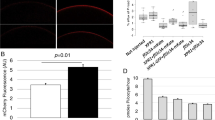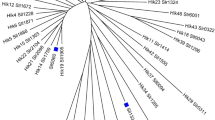Abstract.
When expressed in Xenopus oocytes KAAT1 increases tenfold the transport of l-leucine. Substitution of NaCl with 100 mm LiCl, RbCl or KCl allows a reduced but significant activation of l-leucine uptakes. Chloride-dependence is not strict since other pseudohalide anions such as thyocyanate are accepted. KAAT1 is highly sensitive to pH. It can transport l-leucine at pH 5.5 and 8, but the maximum uptake has been observed at pH 10, near to the physiological pH value, when amino and carboxylic groups are both deprotonated. The pH value mainly influences the V max in Na+ activation curves and l-leucine kinetics. The kinetic parameters are K mNa = 4.6 ± 2 mm, V maxNa = 14.8 ± 1.7 pmol/oocyte/5 min for pH 8.0 and K mNa = 2.8 ± 0.7 mm, V maxNa = 31.3 ± 1.9 pmol/oocyte/5 min for pH 10.0. The kinetic parameters of l-leucine uptake are: K m = 120.4 ± 24.2 μm, V max = 23.2 ± 1.4 pmol/oocyte/5 min at pH 8.0 and K m = 81.3 ± 24.2 μm, V max = 65.6 ± 3.9 pmol/oocyte/5 min at pH 10.0.
On the basis of inhibition experiments, the structural features required for KAAT1 substrates are: (i) a carboxylic group, (ii) an unsubstituted α-amino group, (iii) the side chain is unnecessary, if present it should be uncharged regardless of length and ramification.
Similar content being viewed by others
Author information
Authors and Affiliations
Additional information
Received: 27 April 1999/Revised: 10 January 2000
Rights and permissions
About this article
Cite this article
Vincenti, S., Castagna, M., Peres, A. et al. Substrate Selectivity and pH Dependence of KAAT1 Expressed in Xenopus laevis Oocytes. J. Membrane Biol. 174, 213–224 (2000). https://doi.org/10.1007/s002320001046
Issue Date:
DOI: https://doi.org/10.1007/s002320001046




